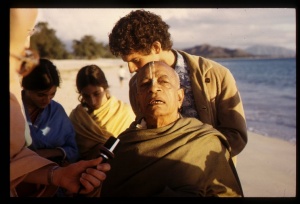SB 4.8.47: Difference between revisions
m (1 revision(s)) |
No edit summary |
||
| Line 1: | Line 1: | ||
{{info | {{info | ||
|speaker= | |speaker=Nārada Muni | ||
|listener=King Dhruva | |listener=King Dhruva | ||
}} | }} | ||
[[Category:Srimad-Bhagavatam - Canto 04 Chapter 08]] | |||
[[Category:Bhagavatam Verses Spoken by Narada Muni - Vanisource|040847]] | |||
<div style="float:left">'''[[Srimad-Bhagavatam]] - [[SB 4|Fourth Canto]] - [[SB 4.8: Dhruva Maharaja Leaves Home for the Forest|Chapter 8: Dhruva Mahārāja Leaves Home for the Forest]]'''</div> | |||
<div style="float:right">[[File:Go-previous.png|link=SB 4.8.46]] '''[[SB 4.8.46]] - [[SB 4.8.48]]''' [[File:Go-next.png|link=SB 4.8.48]]</div> | |||
{{RandomImage}} | |||
==== TEXT 47 ==== | ==== TEXT 47 ==== | ||
<div | <div class="verse"> | ||
śrīvatsāṅkaṁ ghana-śyāmaṁ | :śrīvatsāṅkaṁ ghana-śyāmaṁ | ||
puruṣaṁ vana-mālinam | :puruṣaṁ vana-mālinam | ||
śaṅkha-cakra-gadā-padmair | :śaṅkha-cakra-gadā-padmair | ||
abhivyakta-caturbhujam | :abhivyakta-caturbhujam | ||
</div> | </div> | ||
| Line 16: | Line 22: | ||
==== SYNONYMS ==== | ==== SYNONYMS ==== | ||
<div | <div class="synonyms"> | ||
śrīvatsa- | ''śrīvatsa-aṅkam''—the mark of Śrīvatsa on the chest of the Lord; ''ghana-śyāmam''—deeply bluish; ''puruṣam''—the Supreme Person; ''vana-mālinam''—with a garland of flowers; ''śaṅkha''—conchshell; ''cakra''—wheel; ''gadā''—club; ''padmaiḥ''—lotus flower; ''abhivyakta''—manifested; ''catuḥ-bhujam''—four handed. | ||
</div> | </div> | ||
| Line 23: | Line 29: | ||
==== TRANSLATION ==== | ==== TRANSLATION ==== | ||
<div | <div class="translation"> | ||
The Lord is further described as having the mark of Śrīvatsa, or the sitting place of the goddess of fortune, and His bodily hue is deep bluish. The Lord is a person, He wears a garland of flowers, and He is eternally manifest with four hands, which hold [beginning from the lower left hand] a conchshell, wheel, club and lotus flower. | The Lord is further described as having the mark of Śrīvatsa, or the sitting place of the goddess of fortune, and His bodily hue is deep bluish. The Lord is a person, He wears a garland of flowers, and He is eternally manifest with four hands, which hold [beginning from the lower left hand] a conchshell, wheel, club and lotus flower. | ||
</div> | </div> | ||
| Line 30: | Line 36: | ||
==== PURPORT ==== | ==== PURPORT ==== | ||
<div | <div class="purport"> | ||
Here in this verse the word puruṣam is very significant. The Lord is never female. He is always male (puruṣa). Therefore the impersonalist who imagines the Lord's form as that of a woman is mistaken. The Lord appears in female form if necessary, but His perpetual form is puruṣa because He is originally male. The feminine feature of the Lord is displayed by goddesses of fortune—Lakṣmī, Rādhārāṇī, Sītā, etc. All these goddesses of fortune are servitors of the Lord; they are not the Supreme, as falsely imagined by the impersonalist. Lord Kṛṣṇa in His Nārāyaṇa feature is always four handed. On the Battlefield of Kurukṣetra, when Arjuna wanted to see His universal form, He showed this feature of four-handed Nārāyaṇa. Some devotees are of the opinion that Kṛṣṇa is an incarnation of Nārāyaṇa, but the Bhāgavata school says that Nārāyaṇa is a manifestation of Kṛṣṇa. | Here in this verse the word ''puruṣam'' is very significant. The Lord is never female. He is always male ''(puruṣa)''. Therefore the impersonalist who imagines the Lord's form as that of a woman is mistaken. The Lord appears in female form if necessary, but His perpetual form is ''puruṣa'' because He is originally male. The feminine feature of the Lord is displayed by goddesses of fortune—Lakṣmī, Rādhārāṇī, Sītā, etc. All these goddesses of fortune are servitors of the Lord; they are not the Supreme, as falsely imagined by the impersonalist. Lord Kṛṣṇa in His Nārāyaṇa feature is always four handed. On the Battlefield of Kurukṣetra, when Arjuna wanted to see His universal form, He showed this feature of four-handed Nārāyaṇa. Some devotees are of the opinion that Kṛṣṇa is an incarnation of Nārāyaṇa, but the Bhāgavata school says that Nārāyaṇa is a manifestation of Kṛṣṇa. | ||
</div> | </div> | ||
__NOTOC__ | |||
<div style="float:right; clear:both;">[[File:Go-previous.png|link=SB 4.8.46]] '''[[SB 4.8.46]] - [[SB 4.8.48]]''' [[File:Go-next.png|link=SB 4.8.48]]</div> | |||
__NOTOC__ | |||
__NOEDITSECTION__ | |||
Revision as of 12:44, 10 May 2021

A.C. Bhaktivedanta Swami Prabhupada
TEXT 47
- śrīvatsāṅkaṁ ghana-śyāmaṁ
- puruṣaṁ vana-mālinam
- śaṅkha-cakra-gadā-padmair
- abhivyakta-caturbhujam
SYNONYMS
śrīvatsa-aṅkam—the mark of Śrīvatsa on the chest of the Lord; ghana-śyāmam—deeply bluish; puruṣam—the Supreme Person; vana-mālinam—with a garland of flowers; śaṅkha—conchshell; cakra—wheel; gadā—club; padmaiḥ—lotus flower; abhivyakta—manifested; catuḥ-bhujam—four handed.
TRANSLATION
The Lord is further described as having the mark of Śrīvatsa, or the sitting place of the goddess of fortune, and His bodily hue is deep bluish. The Lord is a person, He wears a garland of flowers, and He is eternally manifest with four hands, which hold [beginning from the lower left hand] a conchshell, wheel, club and lotus flower.
PURPORT
Here in this verse the word puruṣam is very significant. The Lord is never female. He is always male (puruṣa). Therefore the impersonalist who imagines the Lord's form as that of a woman is mistaken. The Lord appears in female form if necessary, but His perpetual form is puruṣa because He is originally male. The feminine feature of the Lord is displayed by goddesses of fortune—Lakṣmī, Rādhārāṇī, Sītā, etc. All these goddesses of fortune are servitors of the Lord; they are not the Supreme, as falsely imagined by the impersonalist. Lord Kṛṣṇa in His Nārāyaṇa feature is always four handed. On the Battlefield of Kurukṣetra, when Arjuna wanted to see His universal form, He showed this feature of four-handed Nārāyaṇa. Some devotees are of the opinion that Kṛṣṇa is an incarnation of Nārāyaṇa, but the Bhāgavata school says that Nārāyaṇa is a manifestation of Kṛṣṇa.